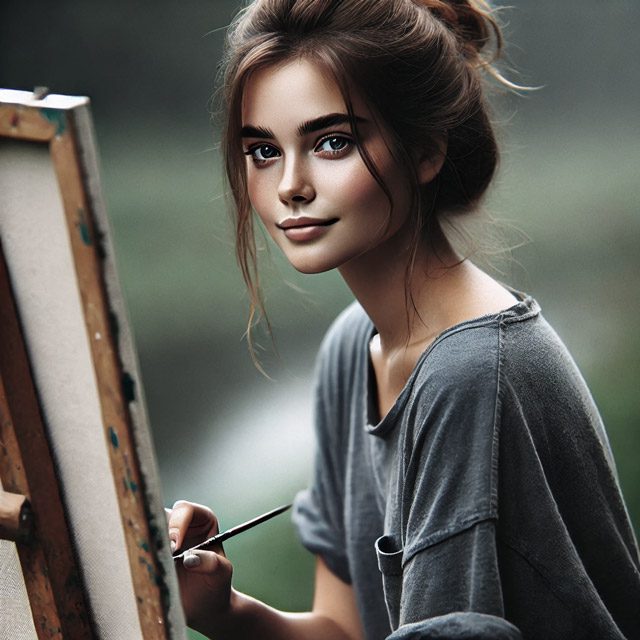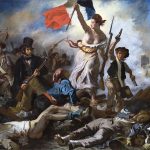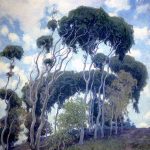
Plein air painting offers artists a chance to escape the studio and immerse themselves in nature, capturing the world as it changes in real-time. The term “plein air,” from the French for “in the open air,” describes the practice of painting outdoors, surrounded by dynamic light and atmospheric conditions. It’s not just about painting a landscape; it’s about experiencing it firsthand. Artists like Claude Monet were captivated by the magic of painting outdoors, and today, plein air continues to inspire painters globally. Let’s dive into the journey of plein air painting and explore how this practice has shaped both art and artists.
What Is Plein Air Painting and How Did It Begin?
Plein air painting refers to the practice of creating art outside, allowing painters to respond directly to nature’s changing light, weather, and atmosphere. This approach was groundbreaking in the 19th century when most painters worked indoors using sketches or models. However, outdoor painting had earlier roots.
In the 17th century, Dutch landscape painters like Jan van Goyen and Jacob van Ruisdael began venturing into the countryside to capture the beauty of nature firsthand. Their detailed depictions of rural life and weathered landscapes brought a fresh realism to European painting. This laid the foundation for what would become plein air painting in the following centuries.
In the 19th century, technological innovations, such as the invention of portable paint tubes in the 1840s, allowed artists to easily leave their studios and paint on location. French painters like Jean-Baptiste-Camille Corot and Théodore Rousseau of the Barbizon School were some of the first to embrace plein air painting fully. They painted in the Fontainebleau Forest, capturing the ever-changing light and seasons. Their work laid the groundwork for the plein air movement that would soon take off with the rise of Impressionism.
The Rise of Impressionism: Plein Air Painting’s Golden Era
The Impressionists took plein air painting to a new level, focusing on natural light, color, and movement. Artists like Claude Monet, Pierre-Auguste Renoir, and Camille Pissarro were drawn to outdoor painting because it allowed them to capture fleeting moments in nature.
Monet’s famous “Haystacks” series showcases this idea beautifully. He painted the same haystack at different times of day and during various seasons, demonstrating how light and weather could transform a scene. His method—quick brushstrokes and a vibrant color palette—allowed him to record these changes in real time.
Monet’s philosophy was that landscapes changed constantly. As he famously said, “For me, a landscape does not exist in its own right, since its appearance changes at every moment.” This approach became central to the Impressionist movement, which focused less on precision and more on the overall feeling and atmosphere of a scene. The bold, visible brushstrokes and vibrant colors associated with Impressionism owe much to the artists’ outdoor observations.
Although their works were initially ridiculed by critics, the Impressionists fundamentally changed the art world, creating a path for modern art movements that followed.
Tools of the Trade: How to Paint Outdoors
Plein air painting requires the right tools and mindset, as artists must adapt to rapidly changing outdoor conditions. The following tools are essential for any plein air artist:
- Portable Easel: These easels are lightweight, collapsible, and often come with storage compartments for paints and brushes. Their portability allows artists to travel to more remote locations easily.
- Paint Tubes: Before the invention of portable paint tubes, artists had to mix and transport pigments in bulky containers. Paint tubes, invented in the 1840s, revolutionized the art world by making outdoor painting far more accessible. Oil paints are traditionally used, but many artists now opt for acrylics or watercolors, depending on their style.
- Brushes: Different brushes are needed for varying effects. Larger brushes are ideal for broad, sweeping landscapes, while smaller ones help with detail work. Many artists also use palette knives to create more textured effects.
- Canvas or Panels: Choose a small to medium-sized canvas that’s easy to carry. Plein air painting typically requires working quickly, and smaller canvases allow for more manageable timeframes as light shifts.
- Palette and Palette Knife: A portable palette helps artists mix colors on-site, adjusting to the natural environment. Palette knives are also useful for applying paint thickly, giving texture to the work.
- Sun Protection and Bug Spray: Since plein air painting involves spending hours outside, sunscreen, a hat, and bug spray are important for comfort. It’s also wise to bring a light jacket or rain gear in case the weather changes.
The biggest challenge of plein air painting is time. Unlike the controlled environment of a studio, where artists can work for hours on a single detail, plein air painters must act fast. The light changes throughout the day, clouds shift, and shadows evolve. This requires artists to focus on capturing the overall atmosphere rather than perfecting every detail.
How Plein Air Painting Changed the Way We See Nature
Plein air painting didn’t just take art outdoors—it transformed how we experience nature. Before the plein air movement, landscapes were often idealized and staged. But artists like John Constable and Jean-Baptiste-Camille Corot brought a new sense of realism to the genre by painting what they saw in front of them.
This shift paralleled the broader influence of Romanticism, where nature was seen as a powerful, almost spiritual force. For plein air painters, nature was no longer just a backdrop—it became the central focus of their work. They sought to capture nature’s beauty in real-time, reflecting its emotional and ephemeral qualities.
By working outdoors, plein air artists brought a fresh intimacy and immediacy to their work. Their paintings captured the fleeting effects of sunlight, the subtle movement of wind through trees, and the texture of grass under the changing sky. These works offered a direct, unfiltered experience of nature that was revolutionary at the time.
Famous Plein Air Painters from Around the World
While plein air painting originated in France, its influence spread across the globe, inspiring artists from many different cultures.
French Masters: Claude Monet, Camille Pissarro, and Alfred Sisley were some of the most famous plein air painters in France. Monet’s “Water Lilies” series, painted in his garden at Giverny, remains one of the most iconic works in art history. Sisley, while less well-known than Monet, was also deeply influenced by nature, devoting much of his life to painting landscapes outdoors.
American Painters: In the United States, artists like Winslow Homer and John Singer Sargent brought plein air painting to new landscapes. Homer’s powerful seascapes, often painted on the coasts of Maine, and Sargent’s expressive brushwork reflect the same commitment to capturing nature in its raw form.
Australian and New Zealand Painters: Artists like Tom Roberts and Arthur Streeton adapted plein air techniques to depict the unique light and landscapes of Australia. As key figures in the Heidelberg School, they helped define Australian Impressionism, bringing attention to the beauty of the Australian wilderness.
Contemporary Plein Air Artists: Today, plein air painting continues to thrive. Artists like Marc Dalessio and Lori Putnam are internationally recognized for their work, which combines traditional techniques with modern perspectives. Festivals such as Plein Air Easton and Plein Air Europe celebrate the practice, drawing artists and audiences from around the world.
Plein Air Painting in Modern Times: A Revival of the Outdoors
In recent years, plein air painting has seen a resurgence. With increasing interest in nature and mindfulness, many artists are rediscovering the joys of painting outdoors.
Social media platforms like Instagram have played a significant role in this revival. Artists use hashtags like #pleinairpainting to share their work, connect with others, and inspire new audiences. Online communities allow plein air painters to exchange ideas, techniques, and even collaborate on projects.
Plein air festivals have also become a popular way for artists to showcase their skills. Events like Plein Air Easton in Maryland and Plein Air Texas attract top artists who paint live in front of audiences, offering demonstrations and workshops. These events create vibrant atmospheres where artists can interact with the public and teach aspiring painters.
Plein air painting has also reemerged as a form of mindfulness. For many, the act of painting outdoors provides a welcome escape from the distractions of modern life. It allows painters to engage fully with their surroundings, focusing on the natural beauty in front of them.
Why You Should Try Plein Air Painting
If you’ve ever considered picking up a paintbrush, plein air painting offers a unique way to improve your artistic skills while connecting with nature. Painting outdoors teaches you to observe how light and shadow interact in real-time, sharpening your ability to see subtle changes in the landscape.
Beyond the technical benefits, plein air painting is also an excellent way to reduce stress. Spending time outside, immersed in the creative process, can be incredibly calming. Whether you’re a professional artist or just beginning, plein air painting offers a chance to reconnect with the world around you.
As Marc Dalessio, a contemporary plein air painter, says, “Painting outdoors is not just about capturing a scene, it’s about capturing a moment in time.” So why not grab your brushes, find a beautiful spot, and start your own plein air journey?
Key Takeaways
- Plein air painting revolutionized the way artists depict light and nature, inspiring movements like Impressionism and Modernism.
- Famous plein air painters like Monet, Pissarro, and Homer created some of the world’s most iconic outdoor works.
- Tools like portable easels and paint tubes made plein air painting accessible to a broader range of artists.
- Today, plein air painting is experiencing a revival, with social media and festivals helping to connect artists.
- Plein air painting is a wonderful way to improve your observation skills, relieve stress, and connect with nature.
FAQs
- What is plein air painting?
Plein air painting refers to painting outdoors, capturing the effects of natural light and the surrounding environment in real-time. - Who are the most famous plein air painters?
Artists like Claude Monet, Camille Pissarro, and Winslow Homer are among the most renowned plein air painters. - What tools do I need for plein air painting?
You’ll need a portable easel, paint tubes, brushes, canvas, a palette, and sun protection for a successful outdoor session. - Why is plein air painting important?
Plein air painting revolutionized landscape painting, allowing artists to capture light and color in real-time and influencing movements like Impressionism. - Why is plein air painting popular today?
A renewed interest in nature, coupled with the rise of social media, has made plein air painting popular again. Artists appreciate the opportunity to disconnect from technology and reconnect with the outdoors.




